News Center
-
 Compressor frosting is very serious what are the reasons? 2020-09-28
Compressor frosting is very serious what are the reasons? 2020-09-28FROSTING is a common phenomenon in therefrigeration system of the compressor return port of the cold storage.Generally, the system problem will not be formed immediately, and the slightfrosting generally need not be dealt with. If Frost phenomenon is more serious,so need to make clear frost reason above all.
FROSTING on the return port of thecompressor
Return Port frosting that compressorreturn temperature is too low, then what will lead to compressor return gastemperature is too low?
With the same mass of refrigerant, thetemperature will behave differently if the volume and pressure are changed. Ifthe return air temperature of the compressor is low, the return air pressure isgenerally low and the refrigerant volume is high at the same time, therefrigerant flowing through the evaporator can not fully absorb the heatrequired to expand to a predetermined pressure-temperature value.
<span lang="EN-US" style="background: whitesmoke; color: rgb(51, 51, 51); font-family:;" 16.5pt;"="" ΢ÈíÑźÚ","sans-serif";="">There are two causes of this problem:
<span lang="EN-US" style="background: whitesmoke; color: rgb(51, 51, 51); font-family:;" ΢ÈíÑźÚ","sans-serif";="" 11.5pt;"="">1, throttle liquid refrigerant supply isnormal, but the evaporator can not normal heat absorption;
<span lang="EN-US" style="background: whitesmoke; color: rgb(51, 51, 51); font-family:;" ΢ÈíÑźÚ","sans-serif";="" 11.5pt;"="">2, the evaporator works properly, but thethrottle valve refrigerant supply is too much, that is, too much refrigerantflow, we usually understand that too much refrigerant.<span lang="EN-US" style="background: whitesmoke; color: rgb(51, 51, 51); font-family:;" 16.5pt;"="" ΢ÈíÑźÚ","sans-serif";="">
<span lang="EN-US" style="background: whitesmoke; color: rgb(51, 51, 51); font-family:;" 16.5pt;"="" ΢ÈíÑźÚ","sans-serif";="">Due to less fluoride caused by thecompressor return frost
<span lang="EN-US" style="background: whitesmoke; color: rgb(51, 51, 51); font-family:;" ΢ÈíÑźÚ","sans-serif";="" 11.5pt;"="">1,Refrigerant traffic is extremely low.Too little expansion of refrigerant will not make use of all the evaporatorarea, only in the evaporator local formation of low temperature, part of theregion as a result of less refrigerant and rapid expansion of low localtemperature, evaporator frosting phenomenon.
<span lang="EN-US" style="background: whitesmoke; color: rgb(51, 51, 51); font-family:;" ΢ÈíÑźÚ","sans-serif";="" 11.5pt;"="">After partial frosting, due to theformation of a heat-insulating layer on the surface of the evaporator and thelow heat transfer in this area, the expansion of the refrigerant is transferredto other areas, and gradually the whole evaporator frosting or icing occurs,and the whole evaporator forms a heat-insulating layer, then the expansion willspread to the compressor return pipe cause compressor return air frosting.
<span lang="EN-US" style="background: whitesmoke; color: rgb(51, 51, 51); font-family:;" ΢ÈíÑźÚ","sans-serif";="" 11.5pt;"="">
<span lang="EN-US" style="background: whitesmoke; color: rgb(51, 51, 51); font-family:;" ΢ÈíÑźÚ","sans-serif";="" 11.5pt;"="">2,Due to the low amount of refrigerant.Low evaporating pressure leads to low evaporating temperature, and willgradually lead to condensation of the evaporator to form a heat insulationlayer, and the expansion point to the compressor back to cause the compressorback gas frosting.
The above two points will be in thecompressor return air frosting before the performance of evaporator frosting.
In fact, in most cases for the phenomenonof Frost, as long as the regulation of hot air bypass valve on the line. Thespecific method: is to open the hot air bypass valve rear end cover, and thenuse No. 8 hexagon wrench, clockwise rotation inside the adjustment nut,adjustment process is not too fast, usually turn about half a circle to pausefor a moment, let the system run for a period of time to see if the frostingsituation before deciding whether to continue to adjust. When the operation isstable and the frost phenomenon of the compressor disappears, then screw theend cover tightly.
FROSTING ON CYLINDER HEAD (crankcase insevere cases)
<span lang="EN-US" style="background: whitesmoke; color: rgb(51, 51, 51); font-family:;" ΢ÈíÑźÚ","sans-serif";="" 11.5pt;"="">FROSTING OF CYLINDER head is due to a largenumber of wet steam or refrigerant inhalation compressor caused. The mainreasons for this are:
<span lang="EN-US" style="background: whitesmoke; color: rgb(51, 51, 51); font-family:;" ΢ÈíÑźÚ","sans-serif";="" 11.5pt;"="">
<span lang="EN-US" style="background: whitesmoke; color: rgb(51, 51, 51); font-family:;" ΢ÈíÑźÚ","sans-serif";="" 11.5pt;"="">
1, the thermal expansion valve opened toolarge, temperature sensor package installation error or fixed loose, so that thetemperature is too high to feel the valve core opened abnormally.
The thermal expansion valve is adirect-acting proportional regulator, which uses the superheat at the outlet ofthe evaporator as a feedback signal and compares it with a given superheatvalue to produce a deviation signal to regulate the flow of refrigerant intothe evaporator, it integrates a transmitter, a regulator and an actuator.
Thermal expansion valve according to the balanceof different ways can be divided into: Internal Balance and external balancethermal expansion valve two kinds.<span lang="EN-US" style="background: whitesmoke; color: rgb(51, 51, 51); font-family:;" ΢ÈíÑźÚ","sans-serif";="" 11.5pt;"="">
<span lang="EN-US" style="background: whitesmoke; color: rgb(51, 51, 51); font-family:;" ΢ÈíÑźÚ","sans-serif";="" 11.5pt;"="">
Thermal expansion valve open too large,temperature sensor package installation error or fixed loose, so that thetemperature is too high and abnormal open Spool, so that a large number of wetsteam into the compressor leading to frosting cylinder head.
If the outlet overheating degree of theevaporator is too large, the rear overheating section of the evaporator will betoo long, and the cooling capacity will be significantly reduced. It is generallybelieved that the expansion valve should be adjusted to the outlet of theevaporator to work at 3 ¡ãC ~ 8 ¡ãC.
2, the supply solenoid valve leakage orshutdown expansion valve closed loosely. A large amount of refrigerant liquidhas accumulated in the evaporator before start-up. This situation is also easyto cause the compressor fluid hit!
3,Too muchrefrigerant in the system. The liquid level in the condenser is higher, thecondensation heat transfer area is reduced, the condensation pressure is increased,that is, the pressure before the expansion valve is increased, the amount ofrefrigerant flowing into the evaporator is increased, the liquid refrigerantcan not completely evaporate in the evaporator, so the compressor inhalation ofwet steam, cylinder head cold or even frosting, and may cause "liquidshock" , while the evaporation pressure will also be high.<span lang="EN-US" style="background: whitesmoke; color: rgb(51, 51, 51); font-family:;" ΢ÈíÑźÚ","sans-serif";="" 11.5pt;"="">
-
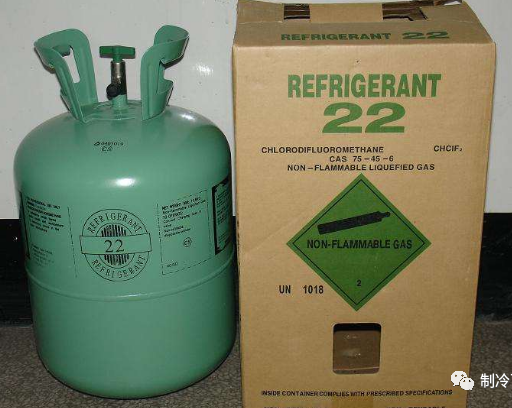 What is the reason for high voltage protection of air conditioning compressor? 2020-09-22
What is the reason for high voltage protection of air conditioning compressor? 2020-09-22To judge whetherthe pressure switch is good or bad, the multimeter can be used to measurewhether the high-voltage protection switch is on or not. If theair-conditioning equipment high-voltage protection, you can refer to thefollowing reasons:
Theexternal fan turns slowly
Maintenance method: air-conditioning fanoutside because of rust or stuck and so on slow the speed of the wind. Clean upthe foreign matter of the air-conditioning fan bearing, and put some lubricanton the fan shaft to restore the fan speed. In addition, the presence of air inthe system
Theoutside is covered with something
The air-conditioning unit placed aroundSundries or covered with things, so that the air-conditioning unit can not benormal heat dissipation. Maintenance method: Don't put sundries around theoutside machine of air conditioner, and don't cover things on the outsidemachine.
Too muchrefrigerant
Excessive refrigerant will also make theair-conditioning internal pressure is too large, leading to high-pressureair-conditioning maintenance methods: As long as the release of excessrefrigerant can be solved.
Theambient temperature is too high When the outsideenvironment reaches 43 degrees of high temperature, air conditioning heatingwill appear the phenomenon of heat dissipation difficulties, then the airconditioning will appear high pressure protection, when the outdoor airconditioning is difficult to work above 43 degrees, only temporarily do notturn on the air conditioning
Controlloop anomaly When the control circuit ofthe air-conditioner is out of order, the air-conditioner can not work normally,which leads to the increase of the internal pressure, at this time there willbe protection. Check the control circuit where there is a problem, thereplacement of the corresponding parts can solve the problem.
Otherreasons:
Outside the machine installed in poor heatdissipation environment, such as narrow stairwells, billboards behind, Grilleinside and so on. In the summer, the equipment has been running at high temperature,in fact, the factory laboratory to do experiments, the outdoor environmenttemperature up to 50 ¡ãC, the equipment can runnormally, once the equipment continues to run at high temperature, it can notrun normally until the real high-pressure protection; High pressure protectionvalue of R410a refrigerant reference: 4.2 MP (43kgf/cm)
The high pressure protection value of R22refrigerant is 2.65 MP (26.5 KGF/CM)
The return air space of outdoor units, ina narrow air-conditioning unit inside, only the outside Fan Cooling air outletarea is far from enough, in order to meet the return air (air inlet) space ofequipment, how big the condenser is, how big the return air area is, if thereturn air part of the grid shelter, please also remove, in order to ensuregood ventilation equipment.
-
 Air Conditioning is not lack of refrigerant how to judge 2020-09-06
Air Conditioning is not lack of refrigerant how to judge 2020-09-06Some readers are asking how to judge thelack of air-conditioning refrigerant, in fact, this question is not an accurateanswer, but we summarized the common phenomenon of air-conditioning fluorinedeficiency, hope to help you.
1. windpipe(rough pipe) valve is dry. There is no noticeable cold sensation when touchedwith the hand. The reason is that the temperature of the valve is higher thanthe leakage temperature of the outdoor air due to the excessive increase of therefrigerant.
2. frosting of liquid pipe (Pipette)valve. The reason is that the lack of fluorine causes the pressure in theliquid tube to drop, the boiling point to drop, so that the valve temperatureis below freezing point.
3. open the indoor unit panel, remove thefilter screen, you can find part of the evaporator condensation or frosting.Because of the lack of refrigerant, only part of the evaporator boiling heat,so that the corresponding reduction of the cooling area.
4. Outdoor exhaust doesn't feel hot. Thereason is that the insufficient refrigerant causes the condensation pressure,the condensation temperature to reduce, the exhaust air temperature alsoreduces.
5. The drain hose drains intermittently ornot at all. The reason is that the evaporator cooling area is reduced,condensation area is also reduced, condensation water reduced.
6£®the outdoor machine gas, the liquid valve has the oil pollution, hasthe oil pollution to have the leak. The reason is that the refrigerant and thefreezing oil have certain mutual solubility, fluorine from the leakage pointescape into the atmosphere, and the oil adhesion around the leakage point.
7£®Measure the working current of the air conditioner is less than therated current. The reason is the lack of refrigerant and reduce the compressorworkload, the current drop.
8. The pressure measured from thefluorine-filled mouth of the outdoor machine is less than 0.45 MPA. The reasonis that the lack of refrigerant led to a reduction in the evaporation pressure.
In addition, the following methods can beused to aid judgment:
Try: Theair conditioning on for a period of time after the wind blowing on the bodyfeel cool, and can quickly reach the set temperature, outdoor compressor can belike a refrigerator open for a while to stop for a while is normal.
Measure:use thermometer to measure the temperature difference between the inlet andoutlet of the indoor machine. The difference above 8 ¡ãC is normal. The bigger thetemperature difference is, the better the working condition of the airconditioner is.
see: in the boot more than 10 minutes, see outside the machine twocopper pipe, thick copper pipe should be dew, thin copper pipe should not bedew, open the indoor machine panel, should see evaporator evenly covered withcondensation water (like dew) for normal, if half is half without, probablyfluoride deficiency. If the local frosting or icing is not normal.
touch: If the outdoor machine in thehuman hand can touch the place, can be turned on more than 10 minutes after thehand touch. The outdoor machine has two copper valves, one with thick copperpipe and one with thin copper pipe. Two valves should be touched by handtemperature difference; thick should be smaller than the temperature, touchcooler for normal (in high temperature should also be condensed water) . Touchoutdoor machine hot air is not hot, if not very hot may lack of fluoride.
-
 What is supercooling and superheating? What does it mean 2020.7.2
What is supercooling and superheating? What does it mean 2020.7.2The so-called "supercooling" means that the saturated liquid after condensation is re-cooled by a device (such as a supercooler) and a method (or measure) to make its temperature lower than the saturated temperature under the condensation pressure. Comparing the liquid temperature before supercooling with that after supercooling, the difference is "supercooling degree" .
The purpose of supercooling is to make the refrigerant liquid before throttling reduce the flash gas produced in throttling process, reduce the specific volume of flash gas occupied, and increase the refrigerating capacity per unit, as well as increase the superheat of return gas, to protect the compressor from the wet stroke operation, there are certain benefits.
In larger refrigeration systems, in order to reduce the temperature of refrigerant liquid entering the throttling valve, reduce the flash gas generated during or after throttling, and improve the refrigeration efficiency appropriately, in the process design, a special equipment for supercooling has been installed after the reservoir (the system using the throttle must have the reservoir) as a supercooler.
Its structure is casing type, spray type, etc. . The principle is to use cooling water lower than the saturated liquid temperature after condensation (such as deep well water) , generally can be compared before cooling again 3 ~ 5 degrees lower temperature (that is, sub-cooling degree of 3 ~ 5 degrees) . Some small fluorine refrigeration systems, such as small cold storage, although there is no special sub-cooler, but the supply pipe and return pipe wrapped together to keep warm, using the return pipe of the low temperature to lower the liquid temperature in the supply pipe, can also be a section of liquid supply pipe and expansion valve directly installed in the warehouse through re-cooling to achieve supercooling purposes, thereby improving the refrigeration efficiency. At the same time, it also heats the temperature of the air return pipe to avoid the possibility of liquid shock caused by the compressor inhaling moisture vapor.
A system of capillary throttling, in which the capillary and the Return Airway (the inspiratory airway) are fused together, welded together, sheathed together with hot rubber, passed through the return airway, and wound around the return airway, some of the capillaries or liquid supply pipe directly in the box through. Source: Refrigeration Encyclopedia Public No. CAPILLARY and return pipe heat exchange, so that the liquid refrigerant before throttling and return pipe low temperature refrigerant steam heat exchange cooling and get undercooling, this can not only reduce the return gas pipeline may entrainment of liquid hit compressor, but also to achieve throttling liquid refrigerant before the goal of supercooling. If the condenser deliberately increased, leaving room for re-cooling and supercooling is also feasible. But in the standard design will not do so, the consideration is to minimize the overall volume and weight, reduce manufacturing costs. For small or micro-capillary throttling systems, no special supercoolers will be added.
Do not talk about the whole condensation process separately. Refer to the inlet or upper part of the condenser as "condensation" and the lower part or the filter as "supercooling" , the difference between the initial temperature and the terminal temperature of the condensation process can not be regarded as the "supercooling degree" , which is wrong! The gas enters from the upper part of the condenser and gradually exchanges heat with the outside world, and the condensing temperature is gradually reduced. Source: Refrigeration Encyclopedia Public Number, finally condensing (liquefying) into a liquid and accumulating in the tail end of the condenser or in the filter, this is the complete condensation process. It can not be said that the upper part of the condenser is condensation and the lower part or some part is supercooling, nor can the inlet temperature of the condenser be subtracted from the outlet temperature as supercooling, or the condensation process of a certain temperature and the outlet temperature difference as the "supercooling" , which is not appropriate, or even wrong, misunderstood the condensation process. Under certain pressure, the temperature is higher than the saturated temperature of the steam, known as superheated steam. Refrigeration compressor exhaust pipe steam temperature, generally higher than the saturation temperature, it is superheated steam, called "exhaust overheating. ".
Due to the length and insulation of the Return Air Pipe (suction pipe) , the steam in the pipe is heated by external transfer. This phenomenon is called "suction overheating" or "pipe overheating" . This kind of superheat will make the suction temperature of the compressor rise, the specific volume of the intake steam increase, resulting in the unit volume of refrigeration reduction, the compressor of refrigeration reduction, which is detrimental to the refrigeration cycle, in this issue known as "harmful overheating. ". Therefore, the suction pipe must be well insulated, as far as possible to reduce the length of the suction pipe, in order to reduce this harmful overheating.
In the fluorine refrigeration system using expansion valve, the superheat is used to adjust the opening degree of thermal expansion valve, which is called "beneficial overheating" . Similarly, the fluorine steam after the heat recovery generated by overheating, but also belongs to the beneficial overheating.
The difference between the saturated temperature before superheating and the saturated temperature after superheating is called superheating degree.
The difference between the saturated temperature before superheating and the saturated temperature after superheating is called superheating degree.
The collation comes from the encyclopedia of refrigeration
-
 Flammable and explosive R290 refrigerant, COME IN TO UNDERSTAND! 2020-05-05
Flammable and explosive R290 refrigerant, COME IN TO UNDERSTAND! 2020-05-05Propane, a hydrocarbon refrigerant, Molecular Formula C3H8, appearance colorless gas, pure odorless, slightly soluble in water, soluble in ether, ethanol, flashpoint ¡ãc-104. The upper explosion limit is% v / V 9.5, the lower explosion limit is% v / V 2.1, the relative density of air is 11.56, the heat of combustion is KJ / Mol: 2217.8, the ignition temperature is 450 ~ 470 ¡ãC. Note: Flash Point: the temperature at which a mixture of steam and air on the surface of a flammable liquid first occurs in contact with fire. Health Hazards: SIMPLE ASPHYXIA and anesthesia. Short-term exposure to 1% propane does not cause symptoms; concentrations below 10% cause only mild dizziness; high concentrations of exposure can lead to anesthesia, loss of consciousness; extremely high concentrations can lead to suffocation. Hazard characteristics: Flammable Gas, mixed with air can form explosive mixture, heat source and open fire with the risk of combustion and explosion, Safety Class A 3. Small charge: R290 refrigerant dosage is only R22, R410A of 40% ~ 55% , less dosage, more economic. Energy Saving: Low freezing point, higher latent heat of evaporation, faster cooling rate per unit time; less isentropic compression than work, easier compressor work, longer compressor life; small molecular weight, good fluidity, lower conveying pressure, reduced the load of the compressor. Using R290 refrigerant, the energy saving rate can reach 15 ~ 30% .

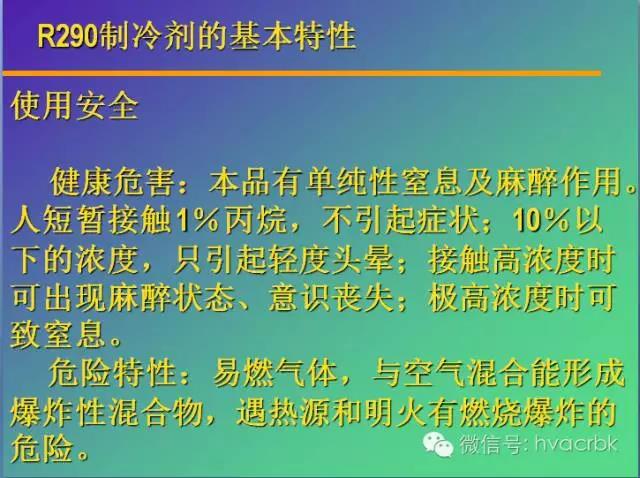
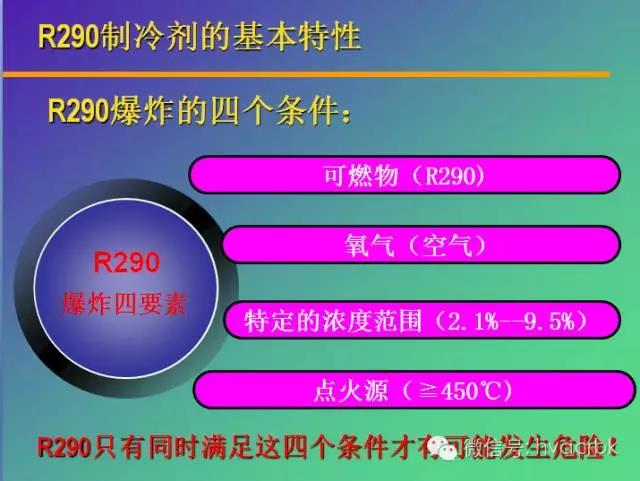
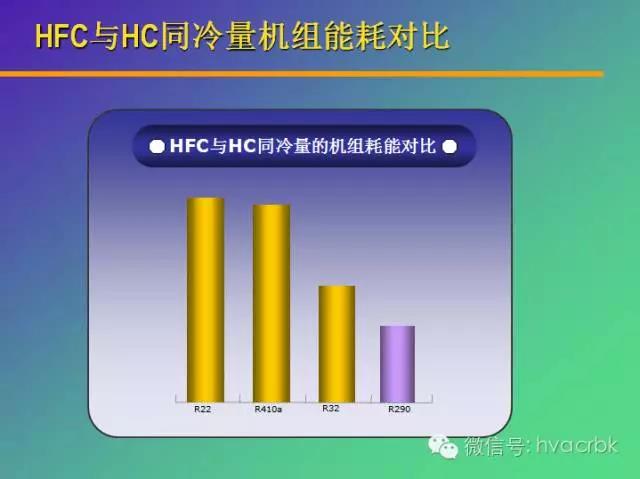
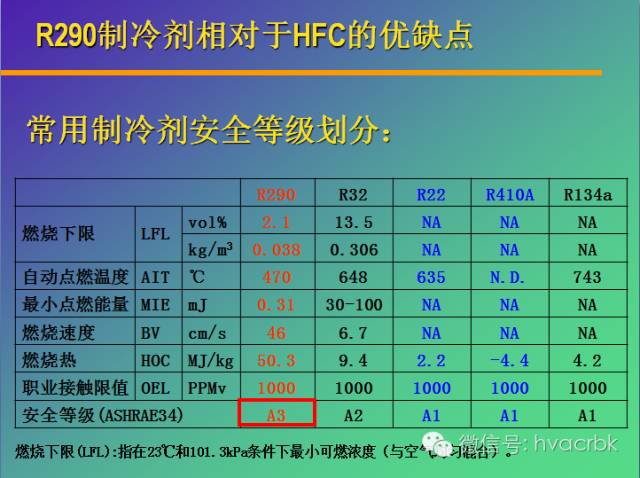



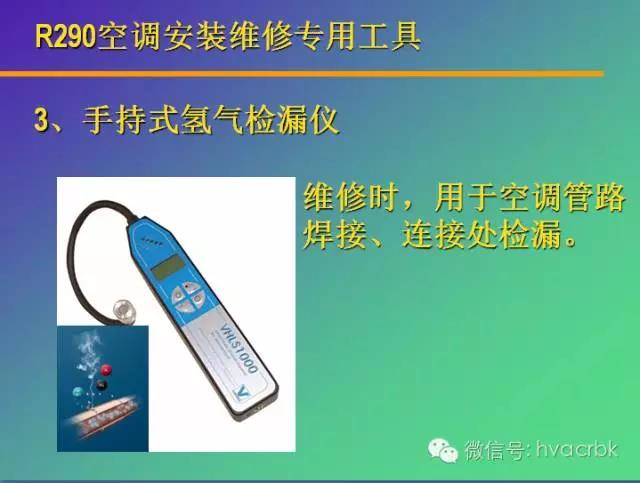
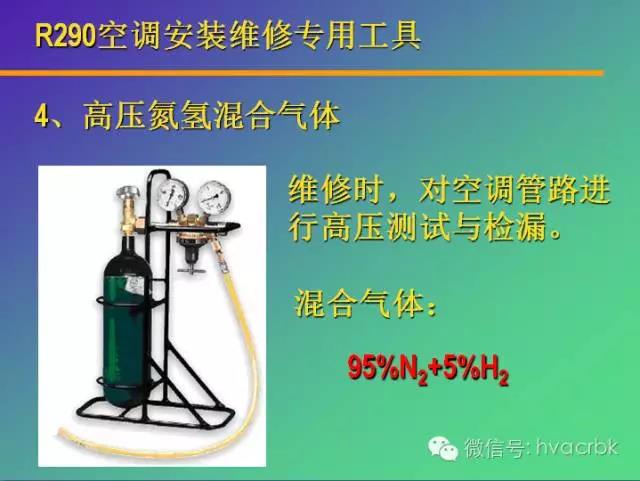
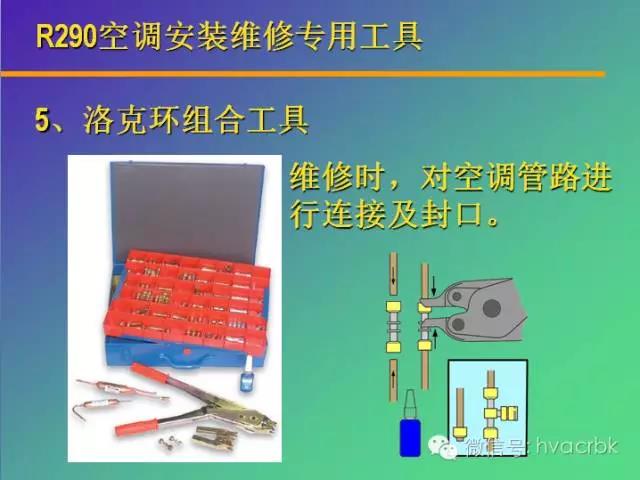
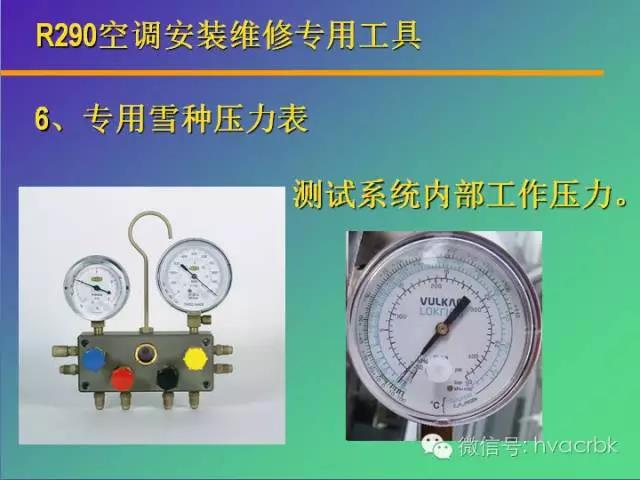
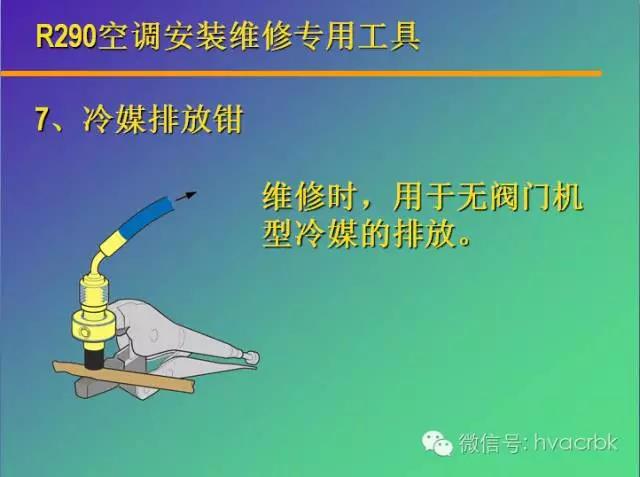
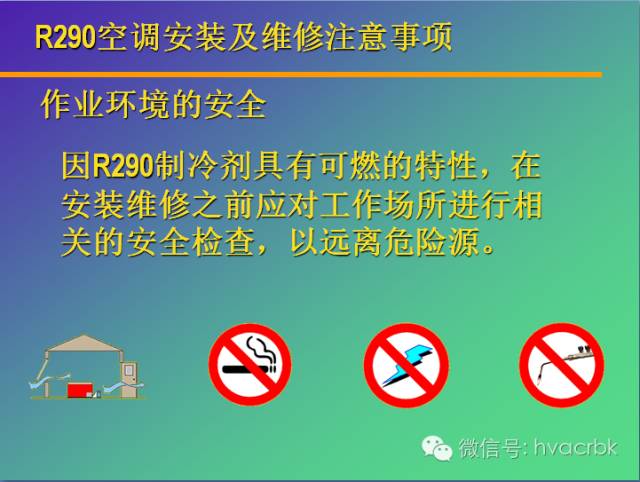
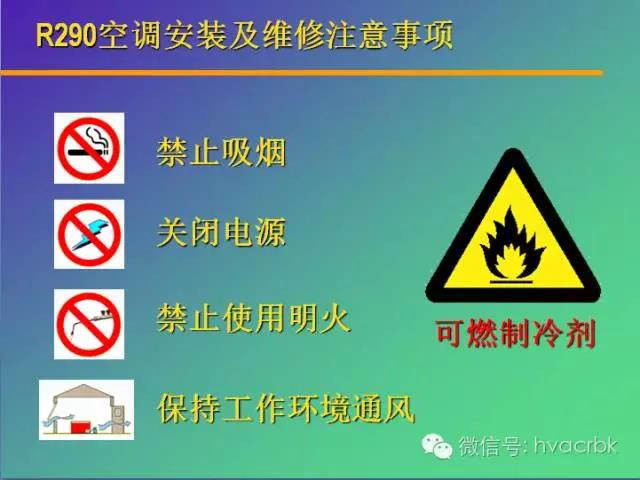
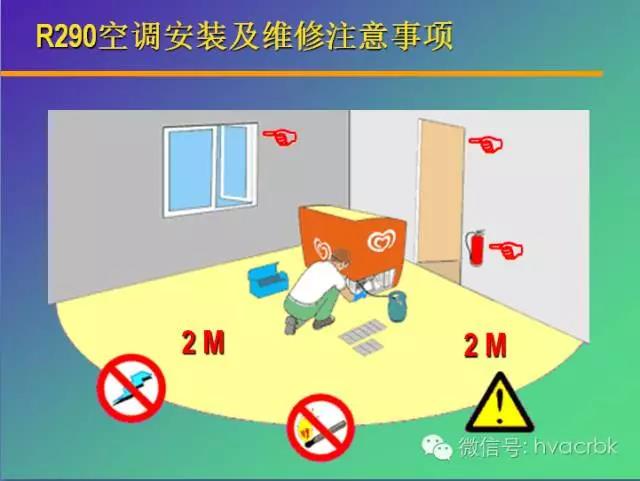
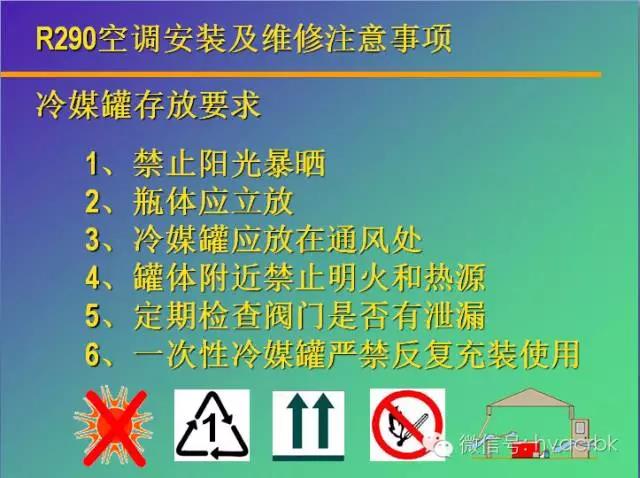
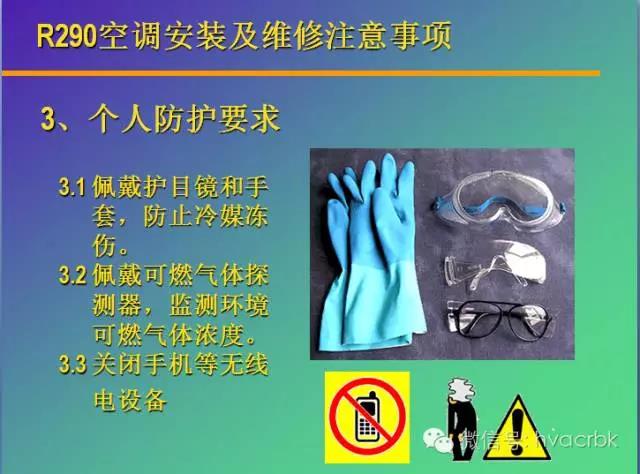
Article Collation from the "encyclopedia of refrigeration"
cold and warm life, Binger accompanied ! -
 Commercial Air conditioning compressor replacement reference 2020-04-21 Commercial Air conditioning compressor replacement reference
Commercial Air conditioning compressor replacement reference 2020-04-21 Commercial Air conditioning compressor replacement referencestep 1: Cut off the power supply, confirm the compressor damage needs to be replaced, first disconnect the outdoor machine power supply switch, disconnect the power supply wiring, disconnect the outdoor unit from the power supply and seal it with an insulating tape.


step 2: Clean the electrical box components. When removing the compressor wiring, the temperature sensor and the electric heating, the corresponding marks should be made to facilitate the rewiring after replacement.
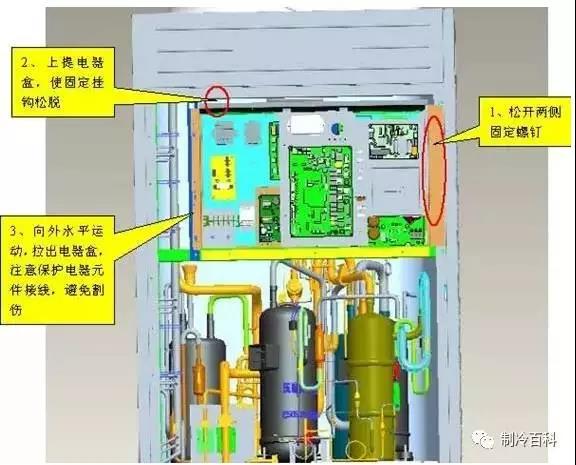
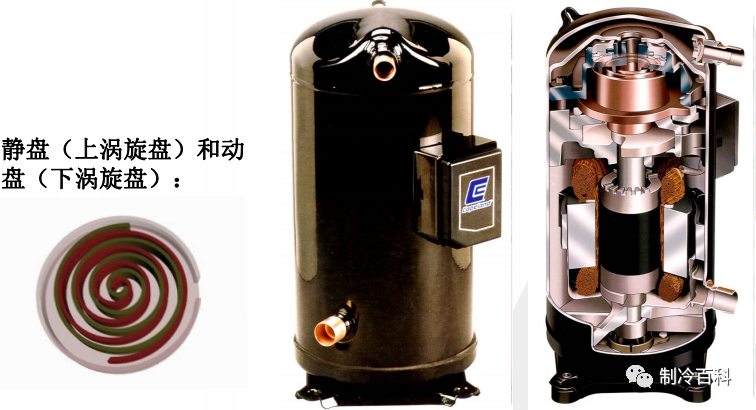
step 3: Release the refrigerant, the refrigerant of the system, should be released from both the high and low pressure sides of the system. If the air is released from only one side, the scroll seal will result in incomplete refrigerant release. Do not release the refrigerant too quickly, or a large amount of lubricant will be taken out of the system together with the refrigerant.
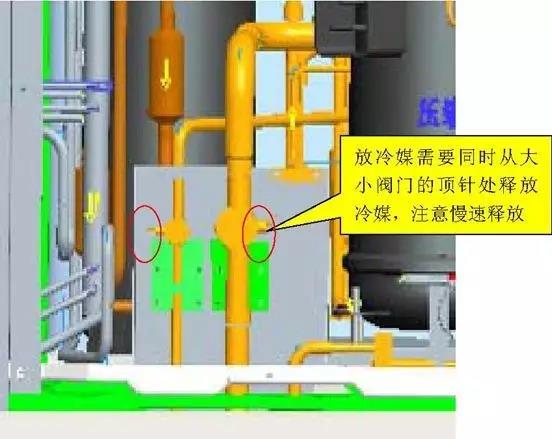
step 4: When the compressor is replaced and the compressor is dismantled to confirm the oil quality, if the oil quality is clear and no impurities are found, the oil quality in the system can be considered not contaminated, while ensuring that the unit valves and oil circuits are not abnormal, you can just replace the compressor.
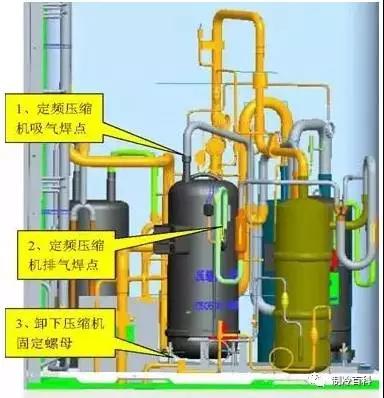
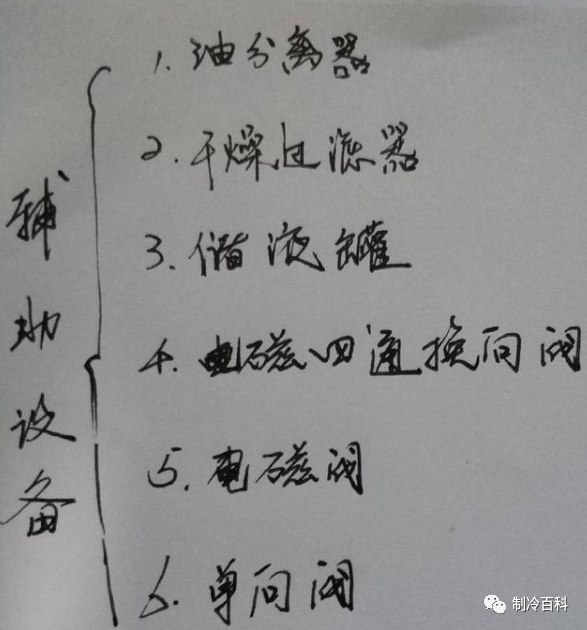
1.Remove the compressor, the compressor in the solid ground shaking, shaking angle should be between 30 ~ 45 degrees (left) , to ensure that the deposition in the bottom of the compressor can be poured out.
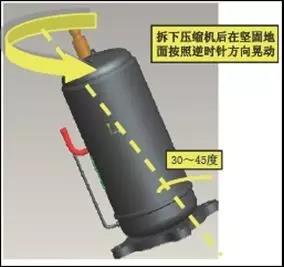
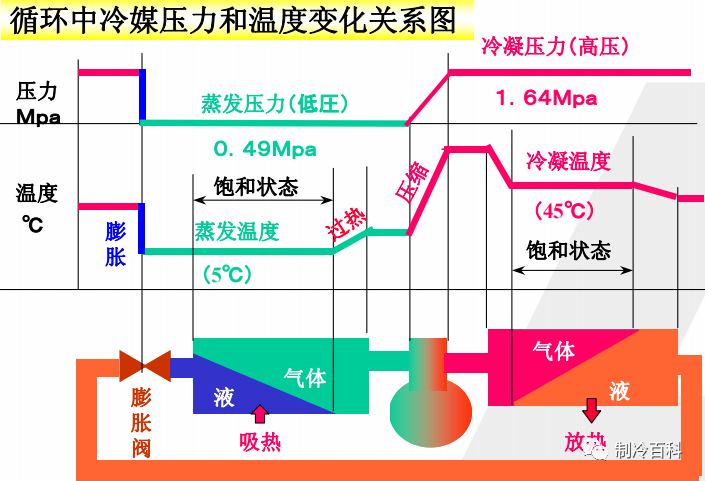
2.Place the compressor above the level of the ground. Pour oil from the compressor outlet. Use a beverage bottle or other transparent container to store the oil. The amount of oil collected should be greater than 150 ml. Note that the compressor axial position and horizontal angle should not exceed 20 degrees.\
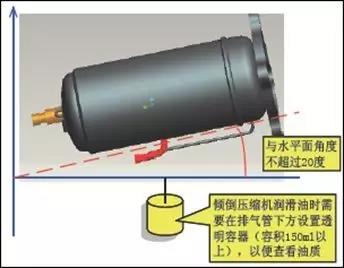
3.Put the collected compressor oil in a bright place to see if it contains impurities and discoloration. Also note the smell of the compressor oil. The normal oil has no obvious pungent smell.
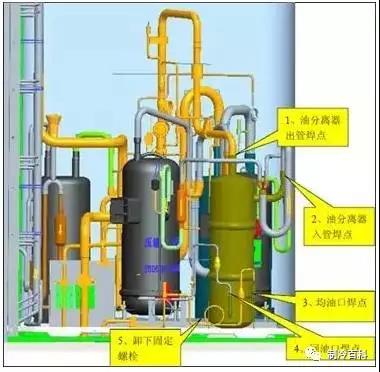
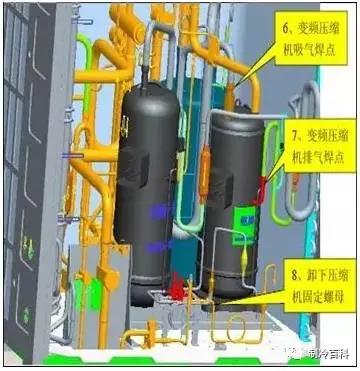
step 5: Confirm the system components, system oil pollution, you need to confirm the unit's components, including the oil separator, gas-liquid separator and storage tank.
1.(oil separation, below) , confirm that there are no impurities, etc. .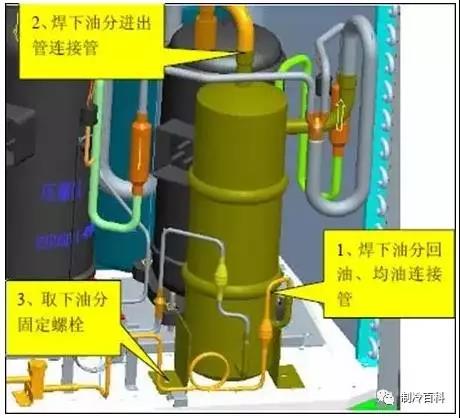
2, gas-liquid separator (below) , check whether there are impurities and other substances.
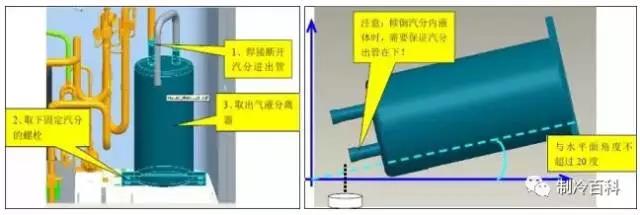
Note: If the compressor damage needs to be replaced, must also replace the gas-liquid separator! Whether or not the gas-liquid separator contains impurities or other abnormal conditions.
3. Remove the tank (below) to confirm that it does not contain any impurities.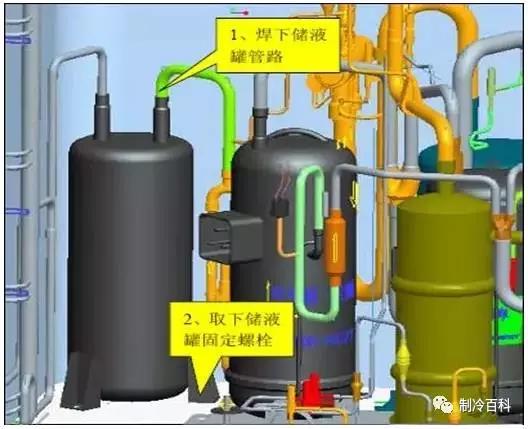
Note: to collect the oil, gas, liquid tank poured out of the compressor oil, and make a good record, to facilitate the replacement of compressor, gas, and other components, the system to add lubricating oil.
Step 6: After cleaning the system and identifying the parts that need to be replaced, make sure that there is no abnormality in the system piping, use nitrogen to blow-wash the main piping, and focus on testing and cleaning the oil piping system.
1.Clean all oil pipeline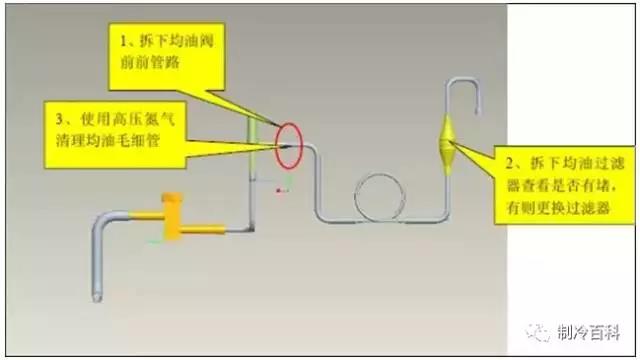
2, CLEAN RETURN OIL PIPELINE
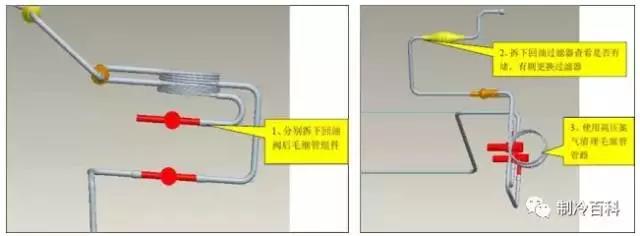
step 7: Check before replacement, check whether the model of the compressor is consistent.
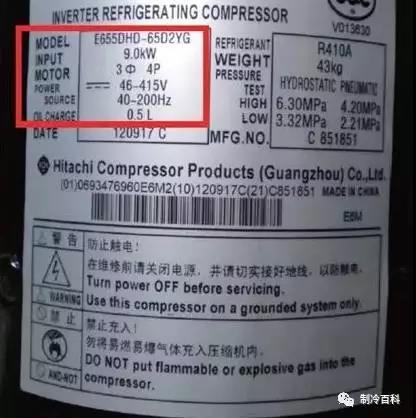
when handling a new compressor, it is necessary to note that the compressor can not be flat or upside down, the angle of tilt should be kept within 30, also pay attention not to let the compressor from the oil balance point of the oil flow.

make sure the sealing rubber blocks of the compressor, oil, steam, oil distributor and drying filter are in good condition.

step 8: replace the gas-liquid separator, place the steam separator in a suitable position with the chassis, connect the steam inlet and outlet pipe, and then connect the nitrogen joint on the steam connection pipe. The position of the nitrogen joint can be selected according to the site conditions, can Use by-pass interface or directly connected in the steam into the pipeline, the pipeline can be used with a larger connection with tape, need to ensure that nitrogen can flow through the steam smoothly.
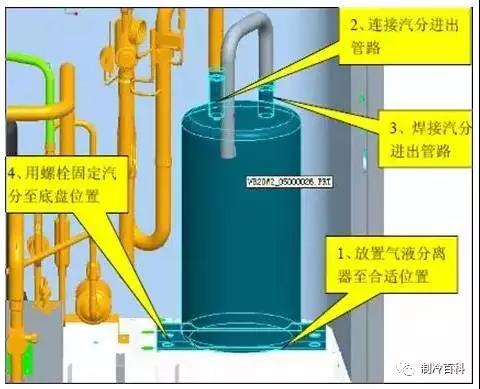
step 9: replace the liquid tank. If the tank is removed after inspection, no foreign matter and impurities can be removed. Because the tank structure is only equivalent to a container tank, does not involve complex structure, and generally does not need to be replaced, however, if there are impurities and foreign matter, it must be replaced, because the tank can not clean up the internal contamination.
Step 10: change the compressor
1, if only the replacement of constant frequency compressor
2, need to change the frequency of compressor
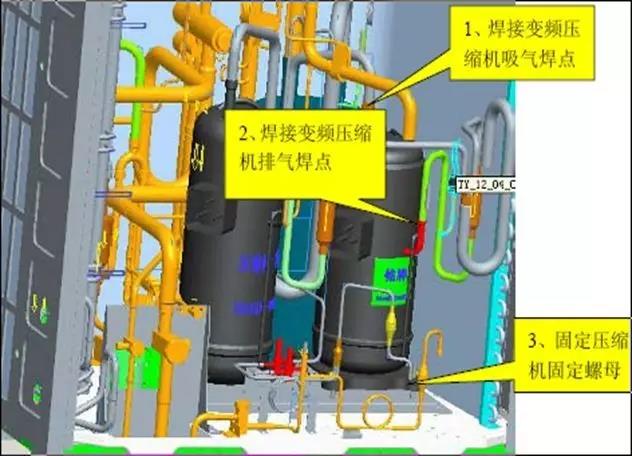
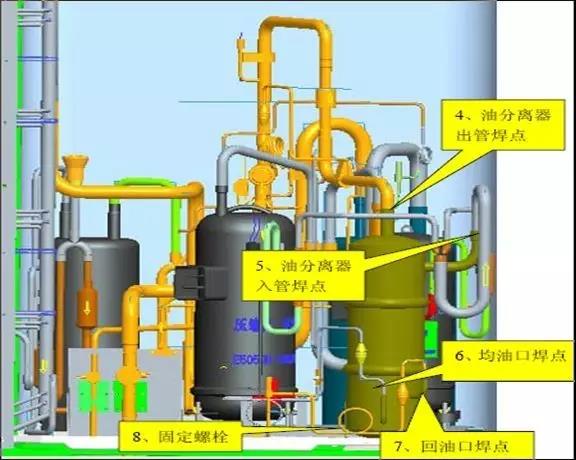
replacement of the compressor need to pay attention to the specific matters:
1, if the compressor suction and exhaust port is copper-plated steel pipe, a solder containing at least 5% silver is required. Welding gap should be 0.1 ~ 0.3 mm, to prevent welding blockage or false welding. Do not overheat the nozzle during welding.
2.After welding the pipeline system, it is necessary to fix the compressor with pads and bolts to ensure the stability of the compressor.
3, the compressor wiring phase sequence error or frequency conversion and fixed frequency mixing of the situation.
Step 11: change the oil separator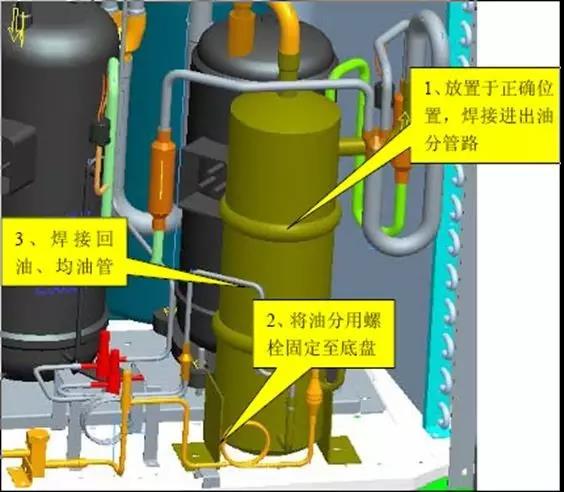
step 12: System leak detection
1, first for each solder joint inspection, first observe whether the solder joint is smooth and there is no obvious welding hole and other abnormal conditions;
2, for the Unit System Nitrogen pressure, make the system pressure above 25kgf, close the unit size valve, ensure the pressure inside and outside the machine at the same time above 12h, if the pressure does not change, you can start to vacuum, otherwise to re-leak detection until leak detection.
Step 13: Add Refrigeration Oil
1, connect the unit size valve, vacuum more than 30 minutes. Connect the low pressure measuring valve with a rubber tube, open the container where the oil is stored, and pour the oil into the measuring cup to measure the appropriate additional amount. After adding proper lubricant, close the low pressure measuring valve to ensure the seal.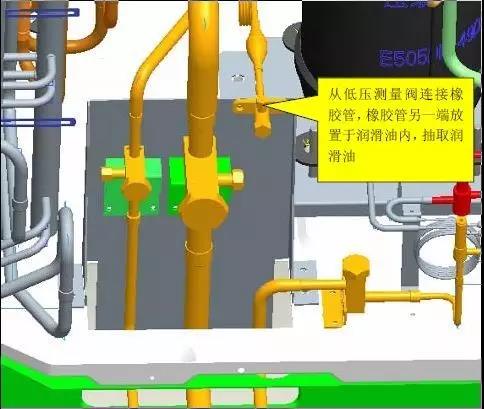
Note: The refrigerant oil of the compressor plays a very important role in the normal operation of the compressor. It must be filled with the correct grade and quality lubricating oil according to the requirements of the equipment.
Step 15: Filling Refrigerant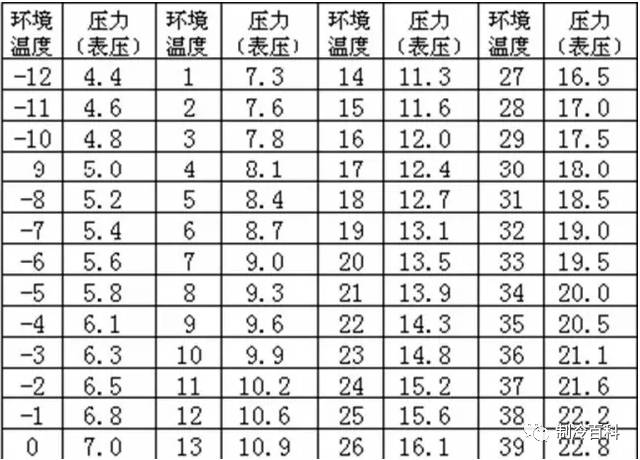
additional refrigerant charge calculated according to the Nameplate Rating Plus Piping; if the unit is a multi-module connection installation, only the refrigerant of the unit outside the unit is released before maintenance, after pouring 80% of the rated pouring amount of the nameplate of the external machine, the adjustment is made through the starting and debugging parameters.
Step 16: Connect the electrical components, install the electrical box, connect the compressor cable and the corresponding electrical heating tape according to the previous mark and the circuit diagram behind the electrical box cover. Note: must be carefully checked according to electrical wiring diagram, must ensure that the wiring is correct!
Step 17: start-up Commissioning, Unit start-up commissioning, respectively running refrigeration full-open, refrigeration single-open, heating full-open and heating single-open unit operating conditions, each operating condition requires operation of more than 30 minutes, and data analysis, adjustment of the unit system, make sure all the parameters are in order.
Article Collation from the "encyclopedia of refrigeration" cold and warm life, Binger accompanied


